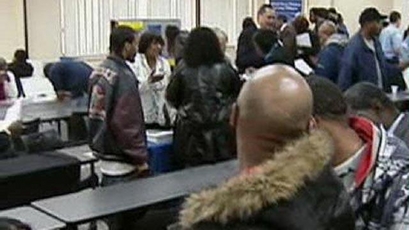The number of U.S. households facing foreclosure in January increased 15 percent from the same month last year, and a surge in cash-strapped homeowners who've fallen behind on mortgages could be on the way.
More than 315,000 households received a foreclosure-related notice in January, RealtyTrac Inc. reported Thursday. That number is down nearly 10 percent from 349,000 in December, which saw the third highest total since the company began tracking foreclosure data in 2005.
In January, one in 409 homes were sent a filing, which includes default notices, scheduled foreclosure auctions and bank repossessions. Banks repossessed more than 87,000 homes last month, down 5 percent from December but still up 31 percent from January 2009.
January marked the 11th straight month with more than 300,000 properties receiving a foreclosure filing. The numbers could stay above that level as unemployed homeowners who have tried to keep up with their mortgages finally start missing monthly payments.
Mortgage financier Fannie Mae reported in late January that the rate of borrowers who have a conventional loan on a house and are seriously delinquent was 5.29 percent in November, more than doubling the rate of 2.13 percent in November 2008. Borrowers are considered seriously delinquent if they are past due by three months or more, or are in foreclosure.
"There's a lot of foreclosures in the pipeline, and the number is going to continue to get bigger," said Patrick Newport, an economist with IHS Global Insight.
Last month's foreclosure activity followed a pattern similar to that of a year ago, when a double-digit percentage increase in December was followed by a 10 percent drop in January.
The dip in January's numbers may be due to processing delays by lenders during the end-of-year holidays, said Rick Sharga, senior vice president of RealtyTrac, which is based in Irvine, Calif.
"I don't think it's an early sign of the coming of the end of the foreclosure crisis," Sharga said.
A record 2.8 million households were threatened with foreclosure last year, and the numbers are expected to rise to between 3 and 3.5 million homes this year, RealtyTrac said.
Slowing the foreclosure rate is a key step in the recovery of the real estate market and the overall economy. The foreclosure crisis forced the federal government and several states to come up with plans to prevent or delay the process to help delinquent borrowers.
Foreclosed homes are usually sold at steep discounts, so they often lower the value of surrounding properties. Cities lose property tax dollars from foreclosure homes that sit empty and from declining home values, straining local economies. Home prices have stabilized in some cities, but are still down 30 percent nationally from mid-2006.
Economic issues, such as unemployment or reduced income, are expected to be the main catalysts for foreclosures this year. Initially, subprime mortgages were mostly the culprit, but homeowners with good credit who took out conventional, fixed-rate loans are the fastest growing group of foreclosures.
Among states, Nevada posted the nation's highest foreclosure rate, followed by Arizona, California, Florida and Utah. Rounding out the top 10 were Idaho, Michigan, Illinois, Oregon and Georgia.
The metro area with the highest foreclosure rate in January was Las Vegas, with one in every 82 homes receiving a foreclosure filing. It was followed by Phoenix and the California cities of Modesto, Stockton, and Riverside-San Bernardino-Ontario.



No comments:
Post a Comment